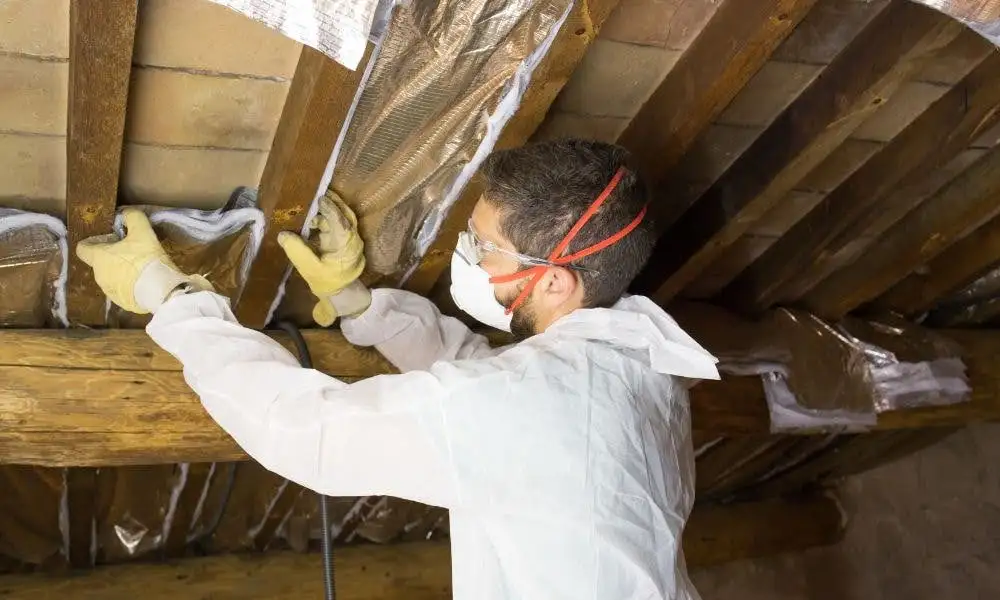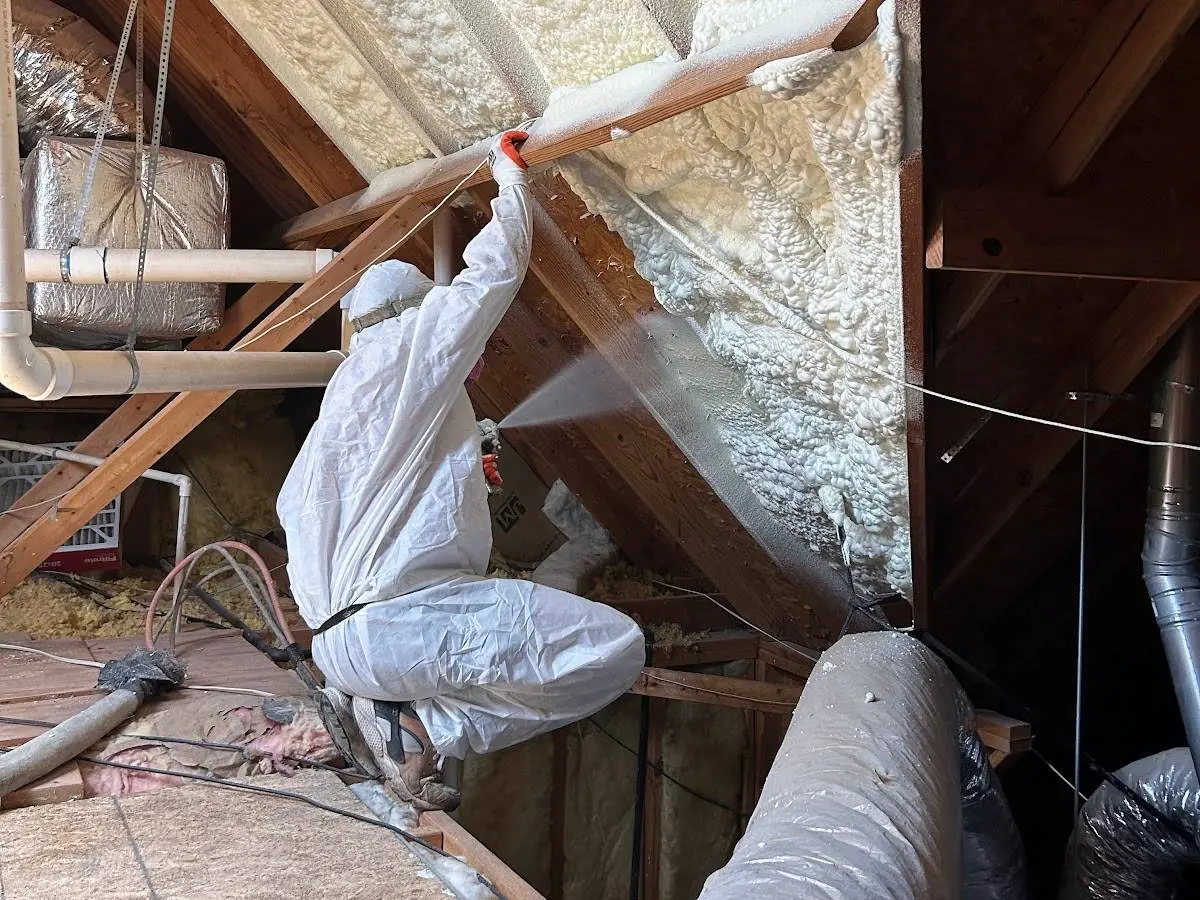Is Spray Foam Insulation Safe? The Ultimate Safety Guide
Spray Foam Insulation Can Lower Energy Bills Up To 45%, But Improper Installation May Trap Toxic Fumes In Your Home For Years.
- What is Spray Foam Made Of?
- Types of Spray Foam Insulation
- Open-Cell
- Closed-Cell
- Application Process
- Health Risks of Spray Foam Installation
- Dangers of Spray Foam During Installation
- Post-Installation Hazards
- Fire Safety
- Environmental Impacts of Spray Foam
- Safety Mitigation Strategies
- Ventilation Systems for Sealed Homes
- Who Should Avoid Spray Foam?
- Popular Incidents and Legal Issues in Spray Foam Safety
- Spray Foam Alternatives
- Frequently Asked Questions
- Can the smell harm you?
- Does spray foam cause asthma?
- Are there 'green' spray foams?
- Should You Use Spray Foam Insulation for Your Home?
Spray foam insulation can lower energy bills up to 45%, but improper installation may trap toxic fumes in your home for years.
With all the benefits it offers, it’s natural to wonder: is spray foam insulation safe for your home?
While it is a top choice for home insulation due to its superior sealing capabilities, there are serious spray foam insulation health concerns if not installed correctly. Poor installation can lead to off-gassing, exposure to harmful chemicals, and long-term health risks.
In this guide, we’ll break down the safety aspects of spray foam insulation, help you understand the potential risks, and show you how to make informed decisions.
What is Spray Foam Made Of?
Spray foam is created by mixing two key components: isocyanate and polyol resin. These chemicals react when combined, causing the foam to expand rapidly, filling gaps and cracks. This reaction provides an airtight seal that helps insulate homes by reducing air leaks and improving energy efficiency.
While it's a great solution, understanding spray foam insulation safety for homes is essential to avoid risks during application.
Types of Spray Foam Insulation
Open-Cell
Open-cell spray foam has a lower R-value of 3.8 per inch, making it suitable for interior applications like walls and attics. It's soundproofing and vapor-permeable, thus allowing moisture to pass through, which can be ideal in dry areas where ventilation is important.
Closed-Cell
Closed-cell spray foam offers a higher R-value of 6.9 per inch, providing superior insulation. It acts as a moisture barrier, making it ideal for areas prone to high humidity, such as basements and crawlspaces. Additionally, it adds structural strength to buildings, enhancing durability.
Application Process
During the application, spray foam is sprayed onto surfaces where it rapidly expands. The foam bonds tightly to surfaces, filling every gap. Once applied, it cures and hardens within 24 - 72 hours, providing a solid, seamless layer of insulation. Proper spray foam insulation safety for homes during this process is vital to prevent chemical exposure.
READ MORE: Complete Guide to Types of Attic Insulation
Health Risks of Spray Foam Installation
Spray foam insulation offers great benefits, but also poses health risks during installation. It’s important to understand the dangers of spray foam insulation to protect those working with it and the people living in the spaces it insulates.
Dangers of Spray Foam During Installation
-
Toxic Exposure: The chemicals used in spray foam, particularly isocyanates (MDI/TDI), can cause immediate health issues. These substances may lead to asthma, skin burns, and even long-term sensitization, which can make future exposure more dangerous.
-
VOC Off-Gassing: During installation and curing, spray foam releases volatile organic compounds (VOCs), including formaldehyde, amines, and flame retardants like TCPP. These can cause headaches, nausea, and irritation to the eyes, throat, and lungs.
-
High-Risk Groups: Installers are most at risk during the spraying process, but children, elderly individuals, and those with pre-existing respiratory conditions are also particularly vulnerable to these chemicals. Proper spray foam insulation chemical exposure precautions are necessary to protect everyone.
Post-Installation Hazards
-
Poor Curing Consequences: If the spray foam insulation is not properly mixed or exposed to excessive humidity during installation, it can lead to incomplete curing. This can result in long-term off-gassing of chemicals, affecting air quality over time.
-
Indoor Air Quality Traps: Spray foam creates an airtight seal, but this can concentrate harmful indoor pollutants like CO₂, VOCs, and mold spores. Without proper ventilation, these trapped particles can reduce indoor air quality, creating a hazardous living environment.
-
Removal Risks: If the foam is disturbed, such as during remodeling or insulation removal, it can release toxic dust. Health risks of spray foam insulation increase during these processes, as improper handling can expose workers and homeowners to harmful fibers, and remediation can be complex and costly.
Fire Safety
Spray foam insulation is Class 1 fire-rated, meaning it is resistant to flames to some extent. However, when it burns, it releases hazardous fumes like cyanide and carbon monoxide. This is especially concerning with spray foam in crawlspaces, where fire risks can be heightened.
Firefighters must wear full respirators due to the deadly chemicals released during combustion. While spray foam improves energy efficiency, it’s important to ensure proper fire safety precautions, especially in confined spaces.
Environmental Impacts of Spray Foam
Spray foam insulation, while highly effective at improving energy efficiency, has significant environmental implications, particularly when it comes to its global warming potential (GWP).
Traditional blowing agents used in spray foam, such as hydrofluorocarbons (HFCs), have a GWP that is 725 to 1,030 times greater than carbon dioxide (CO₂). This means that while spray foam insulation can help reduce energy consumption in buildings, its initial environmental impact is considerable due to the high GWP of these blowing agents.
However, advancements in spray foam technology have led to the development of low-GWP alternatives, such as Hydrofluoroolefins (HFOs) and water-blown agents, which have a GWP of 1, significantly lowering their environmental impact. These alternatives are becoming more widely used in spray foam insulation services to mitigate the climate impact of traditional materials.
Despite its improved environmental footprint, spray foam insulation's 25+ year durability presents a trade-off: while it helps to offset its initial carbon footprint through energy savings over time, the material itself is non-recyclable.
READ MORE: Impact of Attic Insulation on Summer Cooling
Safety Mitigation Strategies
Professional installation is crucial when it comes to spray foam insulation. Hiring an experienced, EPA-certified contractor ensures that the job is done correctly and safely.

Look for additional certifications like OSHA and SPFA (Spray Polyurethane Foam Alliance) to verify that the technicians are properly trained in safety standards.
However, safety doesn't rest solely on the technicians. Homeowners and property managers can take important steps to ensure the job is completed professionally. Here are a few critical actions:
-
Confirm that the installer follows spray foam insulation safety standards for homes.
-
Ask for a clear plan on ventilation during and after installation.
-
Ensure the home is vacated during installation, and avoid any re-entry until it's fully cured.
-
Request a post-installation inspection to check for air quality and proper curing.
Ventilation Systems for Sealed Homes
Proper ventilation is essential, especially in sealed homes where spray foam is used. To maintain good airflow and prevent issues like freezing pipes in the attic, use heat recovery ventilators (HRVs) or energy recovery ventilators (ERVs).
These systems exchange indoor air with fresh outdoor air while controlling temperature and humidity, ensuring that harmful fumes and gases are properly expelled. Proper ventilation helps maintain the balance of indoor air quality, protecting both residents and the structure from potential moisture buildup or harmful off-gassing.
For homeowners looking to ensure proper ventilation and air quality during insulation installation, Superior Attic offers expert services to help maintain a healthy home environment. Our team is trained to prioritize safety, quality, and optimal airflow in every project.
Who Should Avoid Spray Foam?
Spray foam insulation offers significant benefits, but it's not suitable for everyone, particularly high-risk individuals who may experience harmful effects from its chemical composition and off-gassing.
Certain groups should consider avoiding spray foam insulation or seek expert guidance before installation:
-
Individuals diagnosed with asthma: Exposure to isocyanates and VOCs in spray foam can trigger asthma attacks or worsen existing respiratory conditions.
-
Individuals sensitive to different chemicals: People with chemical sensitivities may experience irritation, headaches, or nausea from spray foam's fumes during and after installation.
-
DIYers: Spray foam installation requires specialized equipment and knowledge to ensure proper application. DIY attempts can lead to improper curing or dangerous chemical exposure.
-
Children: Due to their developing respiratory systems, children may be more vulnerable to the side effects of spray foam insulation chemical exposure.
-
Elderly individuals: Older adults may have weakened immune systems or pre-existing conditions that make them more susceptible to inhaling harmful fumes.
Popular Incidents and Legal Issues in Spray Foam Safety
There have been several controversial cases highlighting the risks associated with spray foam insulation.
For example, one Phillip Scearce’s home in Florida was filled with a foul-smelling gas after installers cut corners with spray foam insulation. They used a mix of cheaper open-cell foam and covered it with closed-cell foam, which led to a strong odor and health issues.
This situation highlights the importance of carefully vetting contractors to ensure they follow proper installation procedures and use high-quality materials. Scearce and his wife have since dealt with respiratory problems, keeping windows cracked and using a dehumidifier to cope.
Spray Foam Alternatives
Here are some spray foam insulation alternatives to consider for your home:
-
Cellulose: Made from recycled paper and borate-treated for fire resistance (R-3.8/inch).
-
Natural Fibers: Hemp and cotton offer low VOCs, are biodegradable, and eco-friendly.
-
Aerogel: Non-combustible with a high R-value (R-10/inch), but comes at a higher cost.
Tip: To decide which insulation works best for you, consider your specific needs such as climate, budget, and sustainability goals.
If you're concerned about the health risks of spray foam insulation, natural fibers or cellulose could be good alternatives. For superior energy efficiency in colder climates, aerogel may be the ideal choice despite the higher cost, while blown insulation offers a balanced, cost-effective option for many.
Frequently Asked Questions
Can the smell harm you?
Yes, uncured foam fumes cause respiratory distress. Evacuate until fully cured (usually 24 hours or more).
Does spray foam cause asthma?
Isocyanates are a leading cause of occupational asthma; long-term exposure risks are documented.
Are there 'green' spray foams?
Yes! Water-blown, soy-based, or GREENGUARD Gold-certified options reduce risks
Should You Use Spray Foam Insulation for Your Home?
Spray foam insulation offers great energy efficiency and durability. It seals gaps and provides high R-values, making your home more comfortable and reducing energy bills. However, it’s only safe when installed correctly by professionals. Improper installation can lead to off-gassing, harmful fumes, and long-term health risks.
For households with respiratory issues or young children, spray foam might not be the best option. Alternatives like cellulose or natural fibers are safer choices for those concerned about potential chemical exposure.
If you’re asking, "Is spray foam insulation safe?" the answer depends on proper installation. Always hire certified professionals to ensure your home is properly sealed and free from harmful risks.
Superior Attic offers expert spray foam insulation services, ensuring safety, quality, and efficiency for your home.
Contact us today for a consultation and let us help you make the right choice for your insulation needs.

